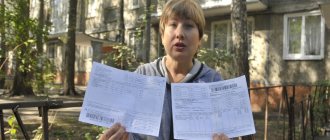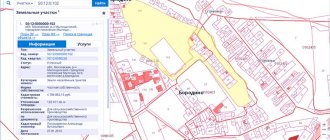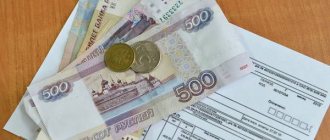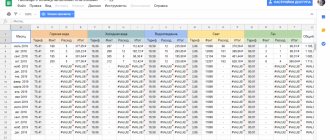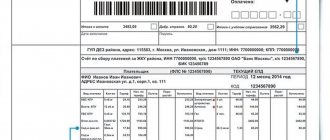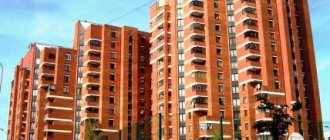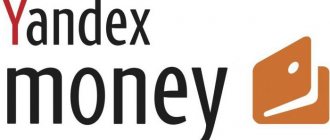What is included in utility bills
Housing and communal services provide for providing comfortable living conditions for citizens in apartment and private buildings. This process is controlled by management companies (MCs), which enter into contracts for the supply of necessary resources.
Before talking about calculating utility bills, you need to consider what is included in their list:
- water supply and sanitation;
- gas;
- electricity;
- heating the room.
Additionally, you need to study payments for the maintenance of the property, maintenance of the intercom, elevator, concierge, major repairs - all this is also included in the payment for housing and communal services.
Note! The management company is responsible for supplying and providing residents with the necessary resources; accordingly, the residents themselves must only promptly pay fees for the above services.
The management company is responsible for calculating payments for utility services.
It is also necessary to understand that common utilities (gas, water, electricity and heating) are provided in all houses, but additional services may vary. For example, not all apartment buildings have a concierge or intercom, which requires a service fee.
Types of payments
The payment document reflecting the list of paid services is a receipt, which is sent to the homeowner on a monthly basis. However, a detailed calculation of housing and communal services payments is not included in this document. It only indicates the types of services, indicating consumption rates and meter readings. Before paying, you need to clarify whether the invoice is correct.
Speaking directly about the general receipt for payment of utilities, it is necessary to indicate what types of payments should be included in the document in question:
- tariffs for water supply and sewerage, latest meter readings, or average cost per month;
- heating (in some houses it is calculated only during the heating season and is based on tariff indicators, and in some all year round in a single set amount);
- gas supply and maintenance, which also assumes an average indicator, or the results of reading the meter;
- electricity, which is reflected in the form of kW indicators per month;
- major repairs;
- maintenance of common property.
If additional services are available, the management company will also issue invoices for payment according to the tariffs.
Note! The receipt must contain information about the payer, the square footage of the premises and the personal account number. In addition, it is necessary to indicate tariffs and background information, otherwise the payment document cannot be considered correct.
Separate mention should be made about each type of payment, since they have their own characteristics of calculating payment and establishing average consumption indicators and tariffs.
For housing services
This category includes payments related to the maintenance of common property. There are no counter indicators provided here. The management company sets tariffs for intercom maintenance, cleaning, property maintenance, garbage removal, and so on. In this case, the cost should be determined according to the standards established by the region.
The cost of housing services is also confirmed by contracts with such suppliers. For example, the management of solid waste, that is, garbage removal, is provided by the relevant company of the city, with which the management company enters into an agreement, negotiates a price, and then, based on the agreement, issues an invoice to the homeowner.
For utilities according to standards
The list of utility bills includes payment for those services for which it depends either on the amount of consumption or on average standards. If the homeowner does not have metering devices, then the management company issues an invoice based on average indicators.
For example, accounting for the amount of water consumed in an apartment is not provided due to the lack of meters. The Criminal Code determines the average amount of consumption - 5 cubic meters of hot water per month, regardless of whether this amount is actually consumed or not. Accordingly, payment occurs at the regional tariff for 5 cubic meters. The owner can spend less or more hot water, the amount of payment will remain unchanged. The same principle applies when determining the cost of light and gas.
For utilities according to meter readings
The next category of payments is based on readings from utility meters. The amount of the provided payment for housing and communal services is determined according to the amount of gas or light actually used. From here the corresponding payment is formed.
For example, for a month the electricity meter showed consumption of 160 kW. Consequently, the specified amount of electricity will be paid according to the tariff. However, next month the figure may be different. This type of payment is more convenient and correct, but only applies if there are meters in the apartment.
Average rent for a two-room apartment
Based on federal legislation, local authorities set rent rates.
In some regions, benefits have been introduced for certain categories of citizens:
- pensioners;
- disabled people;
- orphans;
- large families;
- the poor.
On average across the country, a family spends 16.6% of the monthly budget on utility bills, i.e. about 5,500 rubles. This amount is necessary to live in a two-room apartment with 50% wear and tear in winter, located in a five-story brick building without parking or an elevator.
On December 13, 2016, the Moscow Government approved housing and communal services tariffs for the population by Resolution No. 848-PP.
The percentage increases in rates for basic utilities in 2021 (from July 1) are presented in the table:
| Housing and communal services | Tariff growth, % |
| Water supply and sanitation | 7,2% |
| Gas | 3,9% |
| Electricity | up to 7.2% |
| Heat supply | 4,7% |
| Hot water | 10,6% |
It’s easy to calculate what the average rent is for a two-room apartment with an area of 52 m² in Moscow. Without taking into account electricity, the owner needs to pay approximately 4,800 rubles per month if 2 people are registered in the living space.
Calculation of the amount of payments for housing and communal services
The cost of housing and communal services is determined using special formulas applied taking into account the types of payments presented above. The process of establishing the amount of utility payments should be considered in detail using the example of specific types of services.
Gas supply
The cost of gas consumed is calculated using formulas that will differ depending on whether the homeowner has or does not have meters.
The following formulas are used for calculation:
- Q*T*N – option if there are no meters. Q is the number of cubic meters of gas consumed, T is the cost of one cubic meter, N is the standard. An example of the calculation is as follows: 8 cubic meters of gas, the cost of one cubic meter is 7 rubles, the current standard is 5. Thus, 10 * 7 * 5 = 350 rubles. This is how the cost of gas per month is determined based on average indicators. The amount of consumption does not actually matter.
- Q*T is an option if there are meters in the apartment. Calculation example: 4 cubic meters of gas and the cost of one cubic meter is 7 rubles. Thus, 4*7 = 28 rubles. That is, regardless of the number of people in the apartment and the standards, the owner will pay for the gas actually used.
It is more profitable to pay for gas supply according to the readings of the consumption meter; in practice, the average standards are always higher than the actual ones.
Electricity
When calculating payments for electricity, the principle of average standards or meter readings also applies. It should be taken into account that the standards are determined according to the number of people living in the apartment. For example, 65 kW is provided for one person. Five people live in the apartment. In the absence of meters, the calculation will be as follows: 65 * 5 * 4 (cost of one kW) = 1,300 rubles. per month.
Another example of calculation based on meter readings: 157 kW per month according to the meter (the number of residents does not matter). Therefore, 157*4 = 628 rubles. per month of using electricity. This option is also considered more economical, since it involves paying for the resources actually spent.
You can save money when paying by meter
Water supply
Here, the procedure for calculating payment for utility services will be different, since water supply requires establishing the cost of several services at once: hot and cold water, sewerage.
The first calculation example assumes that there are no meters in the apartment: the average consumption of cold water is 7 cubic meters, hot water is 2 cubic meters per person; the cost of a cube is 19 and 80 rubles, respectively, drainage is 20 rubles. per cube; Three people live in the apartment. The calculation is as follows:
- hot water: 2*3*80 = 480 rub.;
- cold water: 7*3*19 = 399 rub.;
- water disposal: (7+2)*3*20 = 540 rub.
As a result, the final cost of water supply will be the total amount of the identified indicators, namely: 480+399+540 = 1,416 rubles. per month.
The second example of calculation assumes the presence of meters: in one month 10 cubic meters of cold water and 5 cubic meters of hot water were used, the cost of a cubic meter according to the tariff is also 19 and 80 rubles, drainage - 20 rubles. The number of people living in the apartment does not matter:
- hot water: 5*80 = 400 rub.;
- cold water: 10*19 = 190 rub.;
- water disposal: (10+5)*20 = 300 rub.
Thus, water supply according to metering devices will cost 890 rubles, which is significantly less than the average.
Heating
The procedure for calculating payment for heating includes several options (only in season or all year round, with and without a meter)
This type of service provides for the most complex procedure for determining their cost. There are several formulas for calculating heating fees, which include the following options:
- If there are no meters and heating is provided only during the season: S*T*N, where S is the area of the apartment, T is the tariff, N is the standard. Example: the area is 70 sq.m, the standard is 0.02 Gcal, the tariff is 1,800 rubles, therefore, 70*0.02*1800 = 2,520 rubles.
- In the absence of a meter, but year-round heating. The formula will be different: S*T*N*k (frequency factor of 0.5). The data can be used from the first example, therefore, 70 * 0.02 * 0.5 * 1800 = 1,260 rubles.
- If there is a meter and seasonal payment. The formula is as follows: V1*(S/S1)*T, where V1 is the total resource consumption, S1 is the total area of the apartments. For example, 5,000 sq.m. – total area, tariff – 1,500 rubles, apartment area – 70 sq.m., general house consumption – 120 Gcal. Therefore, 120*(70/5000)*1500 = 2520 rubles.
- If there is a meter and constant payment for the service. Here you will need to determine Vm - the average volume per square meter, which is carried out according to the formula V (volume per year) / 12/5000 (total area). For example, 720 Gcal/12/5000 sq.m. = 0.012. Therefore, 0.012*70 (apartment area)*1500 (tariff) = 1,260 rubles.
An example is also possible if there are meters in both the apartment and the house. Here you will need to multiply Vm by the total Gcal for the month, for example, 1.512*15000 = 2,268 rubles. However, such a system is rarely used.
The receipt may not reflect the actual amount of payments
If a future buyer simply compares the amounts written in receipts provided by the owners of different apartments, he will almost certainly come to the wrong conclusion about his future living expenses in a particular apartment.
Tatiana Antonova
residential real estate specialist
The buyer cannot always compare the amount of rent paid with the operating conditions of a particular housing. One person can live in a two-room apartment, or maybe four people
.
The consumption of water, electricity, and fees for sewerage will differ significantly. It is also important who lives in the apartment
.
For example, a freelancer working from home will have significantly higher utility costs than someone who goes to work
.
There are simply thrifty consumers, and there are spenders
. The same apartment will be cheap to operate for the first, and expensive for the second. Therefore, a competent realtor will ask sellers about all these nuances and for the buyer will bring the amount of payments for each apartment to a single standard so that they can be objectively compared.
Representatives of utility services mention another aspect that complicates the comparison of apartments in terms of utility costs. Due to retroactive recalculations, accounting departments and other features of the management company, the amount in the payment for some months may be higher or lower than the average. For example, in the winter months of 2021, residents of one block on Elmash paid for heating half as much as a year ago (the rent for three rubles was 3.5-4 thousand), but for May they received receipts with astronomical amounts (for the same three rubles – 12 thousand
. rub.). Therefore, by the way, Tatyana Antonova recommends that apartment buyers look not at one payment, but at least for several months in a row.
Ilya Sotonin
development director of the management company
The amount of payments, in particular for heat, can vary greatly from year to year. There is a new residential complex in Yekaterinburg, for which the utility companies have defended in the Regional Energy Commission a heat tariff that is 1.5 times higher than in the city. Heat is objectively expensive there, due to the fact that a specially built boiler house heats only one house
. But in a few years there will already be a lot of houses there and the cost of maintaining a boiler room per apartment will decrease. As a result, the payment may be lower than in the city.
Table 1. Main factors influencing the amount of rent
| Index | Its impact on the amount of payments |
| Age of the house | The older the house, the more expensive its operation is, mainly due to large heat losses. |
| Local area | A large area requires higher costs for development and maintenance. |
| Number of apartments in the building | The more apartments in a building, the lower the costs of each apartment for general house needs. |
| Availability of a common house heat meter | Recalculation of heating according to the indicators of a common house heat meter allows you to reduce heating costs. For the owner of a two-room apartment, the savings can amount to 3,000 rubles or more . per season. |
| Concierge/Security | The presence of a concierge/security increases the rent by 300-450 rubles. per month. |
Calculation features
The main feature of calculating the amount of payment for receiving utility services is the establishment of the correct tariffs and consumption standards. You should not think that the management company’s calculations are always correct. Tariffs are publicly available, as are the rules for calculating payments.
Another special feature is that the tariffs are valid for six months, there can be no changes, which also allows you to recalculate and determine the cost of utility resources at any time.
From July 1, prices for utilities will increase in Moscow
The amounts were named by regional residents interviewed by KP.
Dear readers, how much money do you spend on utilities? We are waiting for your answers in the comments. The expert told on air how housing and communal services tariffs are formed: Housing and communal services: why tariffs are rising. Live on Radio Komsomolskaya Pravdy we discussed with the expert how the authorities calculate how much we should fork out for everyday amenities Share: Subscribe to the news : Found an error in the text? Select it and press CTRL+ENTER Subscribe to the daily newsletter so you don’t miss interesting materials: ALL COMMENTS289
Where can you quickly calculate housing and communal services payments?
To apply the formula for calculating the cost of utilities, it is not necessary to make the calculations yourself. It is enough to have meter readings and the cost of services at general tariffs, since the website of the Antimonopoly Service of the Russian Federation has access to a special calculator. With its help, you can determine the amount of payments at the apartment address.
Thus, you can determine the amount of payment for utility services yourself, for which it is enough to know the current tariffs and consumption standards for housing and communal services, or use resource consumption meters, which also simplifies the task of controlling the amount of payments.
Order a free legal consultation
